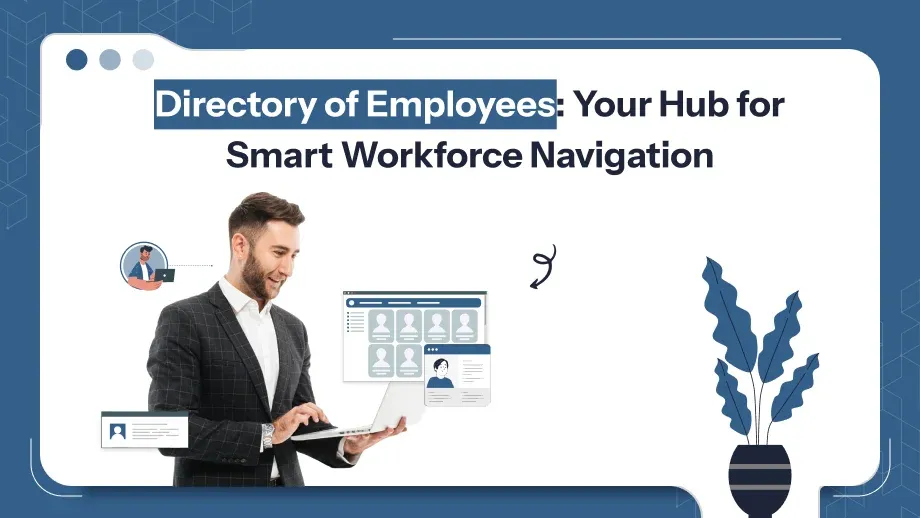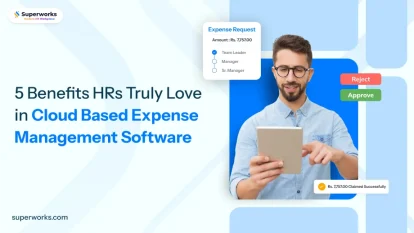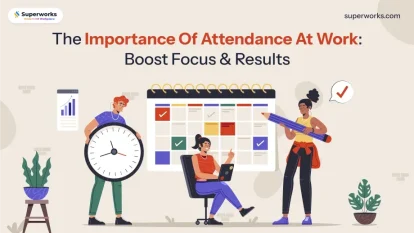
Introduction
A directory of employees is a vital tool in all modern businesses. It functions as a central place to store the employee’s information. It ensures efficient collaboration, seamless communication, and efficiency of the organization. Be it a small team or global workforce planning, having a robust employee listing system makes all the difference.
This blog will explore what an employee directory is, the benefits of its integration, and how integrating it with advanced people directory software can change your organization’s HR processes.
What is a Directory of Employees?
A directory of employees or the employee directory is a central database or system that holds everything that pertains to the employees of a company. It’s the single-point resource for all data about employees in an organization, which includes the names of employees, their contact numbers jobs, titles of employment, department report structures, and even the skills of employees. This application goes far beyond just the basic employee list of a company roster of an organization and offers tools that promote productivity, connectivity, and cooperation.
Key Components of a Directory of Employees
An effective employee directory typically includes the following elements:
1. Basic Information:
- Identify yourself by name, e-mail address, phone number, and employee number.
2. Job Details:
- Job title, department, team, and reporting manager.
3. Contact Information:
- Work location, extension numbers, and emergency contacts.
4. Additional Attributes:
- Skills, certifications, work anniversaries, and other personalized details.
These components make the directory not only functional but also a resourceful tool for streamlining workflows and connecting employees efficiently.
Traditional vs. Digital Directories
Historically, companies used printed directories or static spreadsheets for tracking employee details. While these methods provided basic functionality, they often became outdated quickly and lacked scalability.
1. Traditional Directories:
- Paper-based or static spreadsheets.
- Manual updates lead to inconsistencies.
- Limited accessibility and usability.
2. Digital Directories:
- Cloud-based or software-integrated systems.
- Automated updates for real-time accuracy.
- Accessible anywhere, anytime through mobile or desktop.
The move from traditional to digital directories reflects the changing needs of the modern workplace where speed, accuracy, and convenience are the top priority.
Benefits of a Directory of Employees
A directory of employees is more than just a tool for storing names and contact information. It is a transformative asset for organizations, enabling seamless communication, efficient operations, and a collaborative work environment. Below, we dive into the key benefits of having a directory of employees and how it positively impacts modern businesses.
Enhanced Communication Across Teams
One of the main strengths of an employee directory is it helps bridge any communication gaps found within organizations by providing instant contact information for their employees, whether it is in the form of phone numbers, email addresses, or extensions; this way, teams can be easily connected.
- Cross-Department Collaboration: Teams coming from different departments can easily identify and reach other teams, resulting in faster decisions and project advancements.
- Remote Work Enablement: With the increasing trend of hybrid work models, employee directories help remote employees maintain contact with their coworkers.
Efficient Onboarding Process for Newly Hired Employees
New employees tend to be clueless about the organization’s structure. A directory simplifies this by presenting a clear view of the company list of employees, including their roles and reporting lines, enabling faster integration.
- Easy Access to Key Contacts: New employees can quickly identify their managers, team members, and relevant departments.
- Swifter Integration: Providing an overview of the organization, directories help new employees integrate themselves into the workplace culture and workflows with ease.
Reimagine Workforce Connectivity with a Smarter Directory of Employees!
Unlock seamless access to employee data and elevate team collaboration with our intuitive HRM tool.
Better Productivity and Efficiency
It wastes time trying to find the contact details or the right person to handle a specific task. The directory of employees removes this inefficiency by providing an all-in-one resource for information about employees.
- Fast Decision-Making: It is easy to find the right person to consult or escalate the issue to and, therefore accelerates workflow processes.
- Reduced HR Queries: The employees can get the contact or organizational information from the directory rather than depending on HR, saving time for HR and other staff.
Centralized Employee Data Management
The employee directory provides a single source of truth for all employee-related information. This ensures consistency and accuracy because it is centralized data within the organization.
- Eliminates Redundancy: This can prevent duplicate data since it works with different software, such as HRMS and payroll software.
- Real-Time Updates: This directory is automatically updated, as well as employee information remains current, thereby eliminating any errors or inconsistencies.
Facilitates Internal Talent Discovery
Most organizations fail to identify the right talent from within the organization for a specific project or role. A well-maintained directory can match employees with tasks based on their skills, expertise, or location.
- Skill-Based Searches: Advanced employee directories enable the filtering of employees by their skills, certifications, or past projects.
- Internal Mobility Opportunities: Those employees who are looking for new challenges can easily be identified for internal openings or promotions.
Key Features of a Modern Employee Directory
- Searchable Database Advanced employee directories include intuitive search features that allow users to filter results by department, skill, or role.
- Profile Customization Each employee’s profile can feature job titles, expertise, and even personal interests, promoting better team connections.
- Integration with HRMS Systems The best employee directories integrate seamlessly with HRMS payroll software in India, ensuring smooth data flow and consistency.
- Mobile Access With remote work becoming the norm, having a mobile-friendly employee directory is essential for real-time access.
How to Create an Employee Directory
- Define Objectives Determine what information you need in your directory of employees. Functionality, usability, and scalability.
- Collect Accurate Data Gather all the necessary employee details such as names, roles, and departments. Verify the information to ensure accuracy.
- Choose Reliable People Directory Software Opt for software that offers automation, ease of use, and integration with existing HR systems.
- Design an Intuitive Interface Make the directory visually appealing and user-friendly to encourage adoption among employees.
- Implement and Train Once the directory is ready, train employees on how to use it effectively.
Best Practices for Maintaining an Employee Directory
- Regular Updates Employee roles and departments change frequently. Regularly updating your directory ensures it remains a reliable resource.
- Encourage Employee Participation Allow employees to update their profiles to maintain accuracy.
- Secure Access Use role-based access to protect sensitive data while ensuring everyone can find what they need.
- Monitor Usage Regularly analyze how the directory is being used and implement improvements based on feedback.
Challenges and Solutions
1. Data Accuracy
- Challenge: Outdated or incorrect information can lead to inefficiencies.
- Solution: Schedule periodic audits and use automated updates through software integrations.
2. Adoption Resistance
- Challenge: Employees may hesitate to use the directory.
- Solution: Provide training sessions and highlight the benefits of the directory.
3. Privacy Concerns
- Challenge: Sharing personal information can raise security concerns.
- Solution: Implement strict data protection measures and comply with privacy regulations.
Why Invest in People Directory Software?
People directory software simplifies employee management by automating updates, enabling advanced search features, and offering mobile accessibility. For example, the best HR software in India often includes a built-in directory, making it easier for organizations to manage employee data efficiently.
The Future of Employee Directories
From Static to Intelligent Systems
Traditional employee directories were limited in scope, often requiring manual updates and providing only basic search capabilities. Modern advancements have turned these static systems into intelligent platforms. With the integration of artificial intelligence (AI) and machine learning, directories can now provide proactive solutions to complex workforce challenges.
For instance, AI-powered directories can analyze patterns in employee interactions, project collaborations, and skill utilization to offer tailored recommendations. This transition from being merely a reference tool to an active participant in organizational processes marks a significant leap in the role of employee directories.
Leveraging Predictive Analytics
The next generation of employee directories goes beyond recording current data. They use predictive analytics to provide actionable insights. By analyzing trends in employee behavior, directories can anticipate needs and suggest solutions. They can, for instance, determine which employees have a high risk of becoming burnout by analyzing their workload or spot skill gaps in teams that might hinder the success of tasks.
This type of predictive capability allows organizations to make informed decisions which ensures that resources are used efficiently, and employee happiness is a top priority.
Integration into Organizational Ecosystems
Employee directories are no longer standalone tools; they are becoming integral parts of broader organizational ecosystems. Integration with HR software India, and performance management tools allows directories to function as centralized hubs for all workforce data.
This interconnectedness ensures that any update in one system is propagated across all systems, thereby avoiding errors and duplication. For instance, if an employee’s job in the HRMS is modified, then that change would automatically be updated in the directory to ensure consistency within the organization.
Directory as a tool for Cooperation and Involvement
Future directories will not only connect employees but also foster engagement and collaboration. These systems break the silos that separate employees by allowing them to easily identify their colleagues with particular expertise or interests. The directory can also serve as a means of employee recognition of achievement and further improve the morale of employees, building an appreciation culture.
A Strategic Workforce Planning Tool
The greater the reliance on data for strategic decision-making by organizations, the more employee directories are going to come into the forefront. They are likely to provide information about workforce composition, distribution of skills, and team dynamics to guide everything from project assignments to succession planning.
For instance, a directory integrated with analytics might reveal that a specific department lacks expertise in a critical area, prompting leadership to focus on targeted recruitment or training efforts.
Conclusion
A directory of employees is no longer a luxury but a necessity for organizations looking for efficiency and collaboration. The benefits of an employee directory are clear, ranging from streamlining communication to improving productivity.
Coupled with advanced people directory software, your organization can revolutionize its workforce management. Take the first step today by exploring modern HRMS solutions that include employee directory features and ensure your company stays ahead in the competitive business landscape.






